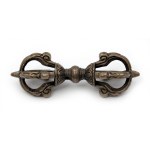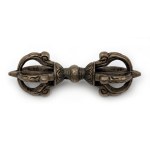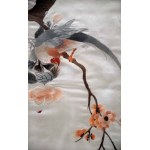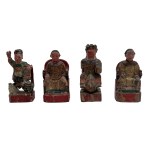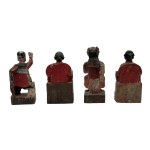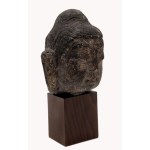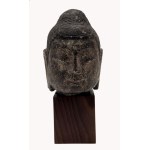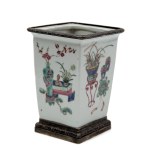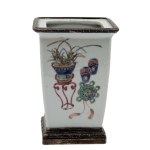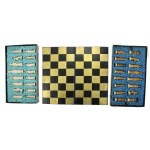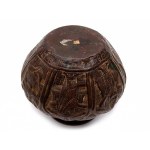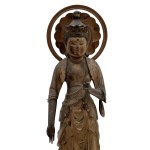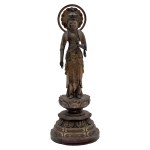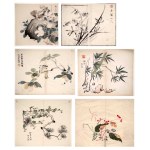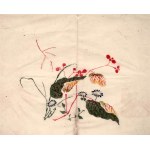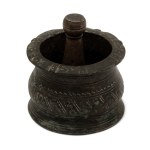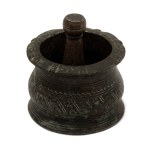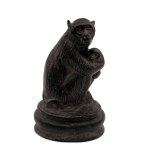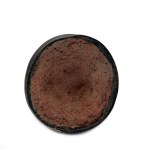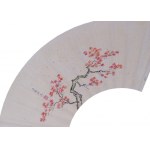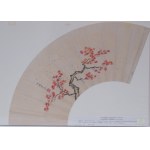Asian art auctions
Ritual vajra scepter with five rays. Tibet/Mongolia, 19th century, length 5 cm. Condition 2Ritual vajra scepter with five spokes. Tibet/Mongolia, 19th century, length 5 cm. Condition 2, Ceremonial scepter vajra with five beams. Tibet/Mongolia, 19th century, length 9.5 cm. Condition 2
Silk embroidery, framed, glazed, Japan circa 1900, dimensions 38 x 100 cm. Condition 2+Silk embroidery, framed, glazed, Japan circa 1900, dimensions 38 x 100 cm. Condition 2+, Silk embroidery, framed, glazed, Japan circa 1900, dimensions 38 x 100 cm. Condition 2+
Wood, three-dimensionally carved, coloured lacquer and gilding. Intricately embossed robes with clouds. China, circa 1900, height 15-15,5 cm. Paint rubbed in places. Condition 2Wood, three-dimensionally carved, coloured lacquer and gilding. Intricately embossed robes with clouds. China, circa 1900, height 15-15,5 cm. Paint rubbed in places. Condition 2, Wood, fully sculpted, colored lacquer an...
Tinned copper inside, brass. Conical body, tapering towards the spout, decorated with brass sleeves, slightly decorated free-moving handle. Mongolia, 19th century, height 36 cm. Condition 2Tinned copper inside, brass. Conical body, tapering towards the spout, decorated with brass ferrules, slightly decorated free-moving handle. Mongolia, 19th century, height 36 cm. Condition 2, Copper, tinned ...
A face with a gentle expression, framed by large overhanging auricles (a symbol of wisdom) depicted with a calm meditative expression, a small round chin, pursed lips and half-closed eyes under arched eyebrows. The hair is neatly arranged in a high knot with an implied ray-like curl in three circles. Remnants of gilding visible. The head is adjusted on a wooden block which serves as a stand. C...
Porcelain glazed, silver of 950/1000 purity. Prismatic shape, painting with variegated enamels on the glaze, Famille rose, silver French mounting. China, late 18th century, mounted France, A. Risler & Carre, Paris circa, 1900, height 19,5 cm. Condition 2+Porcelain glazed, silver 950/1000 purity. Prismatic form, painted with variegated enamels on the glaze, Famille rose, French silver mount...
Chess in a box, China, early 20th century. Chess in a box, bone, box dimensions 19.5 x 33 cm.
Copper vase, wrought with repoussé technique in combination with engravings. With images of Hindu deities and text in bands on the base and neck. India, 19th century, height 13 cm. Condition 2Copper vase, wrought in repoussé technique in combination with engravings. With images of Hindu deities and text in bands on the base and neck. India, 19th century, height 13 cm. Condition 2, Copper vas...
Finely carved and decorated with gold lacquer statue of the Bodhisattva of Compassion with eleven heads and a circular halo standing on a lotus throne supported by a semi-circular base. Her right palm is outstretched in a gesture of generosity, while her left hand, which was supposed to hold the lotus (missing), is held in front of her chest. The circular carved halo is decorated with a bloomi...
1) A pair of sparrows on a rock with pink magnolia, Chikuseki. Shin hanga. Chikuseki (active ca. 1880-1910). Colour woodcut, square shikishi paper. Signature and red seal: Chikuseki. Japan ca. 1900, dimensions 25 x 24 cm. Mounted. Condition 2 2) Bird on a li-chi plant, 32 x 25 cm. 3) Orchids, 30 x 25 cm. 4) Bamboo and stones, 30 x 25.5 cm. 5) Twisted branches of plum and pine trees, 29 x 24 cm...
Bronze, mortar with a belly decorated with a band of engraved stylized flowers, Arabic inscription above. Probably Persia, height 8 cm. Condition 2Bronze, mortar with a ventral body decorated with a band of engraved stylised flowers, Arabic inscription above. Probably Persia, height 8 cm. Condition 2, Bronze, mortar with a bellied body decorated with a band of engraved stylised flowers, Arabic...
Patinated bronze, filled inside, Japan around 1900, height 10 cmPatinated bronze, filled inside, Japan around 1900, height 10 cm, Patinated bronze, filled inside, Japan around 1900, height 10 cm. Condition 2
Tzuš and colours on paper on white gofun ground. Signed Hogen Tanshun. The painter Kano Tanshun (狩野 探春) is a pseudonym of Tsurzawa Tanzan. Tsurzawa Tanzan (鶴沢 探山), 1655-1729, a disciple of Kanō Tanyū. Japan, early 18th century. Length 48 cm. Condition 2Tzush and colours on paper on white gofun ground. Signed Hogen Tanshun. The painter Kano Tanshun (狩野 探春) is a pseudo...
